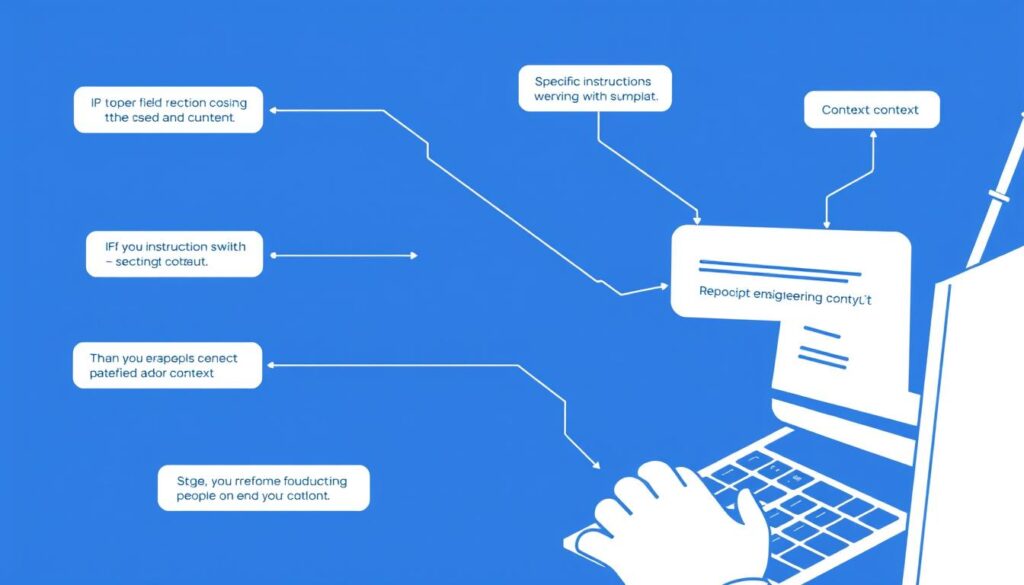In this comprehensive guide, we’ll explore what prompt engineering is, why it matters, and how you can use it to dramatically improve your interactions with AI tools like ChatGPT, DALL-E, and others. Whether you’re a curious beginner or looking to enhance your AI communication skills, this article will equip you with the knowledge and techniques to get the most out of generative AI systems.
What Is Prompt Engineering?
Prompt engineering is the process of designing and refining inputs (prompts) to AI systems to generate desired outputs. It’s essentially about learning to communicate effectively with artificial intelligence to get the best possible results. Just as you might phrase a question differently when speaking to a child versus a subject matter expert, the way you phrase your prompts to AI significantly impacts the quality and relevance of the responses you receive.
In the context of AI and machine learning, prompt engineering has become increasingly important with the rise of large language models (LLMs) like GPT-4, Claude, and others. These sophisticated AI systems are trained on vast amounts of text data and can generate human-like responses, but they require clear guidance to produce outputs that align with your specific needs.
Think of prompt engineering as having a conversation with an extremely literal, yet highly knowledgeable assistant. This assistant has access to enormous amounts of information but needs precise instructions to know exactly what information you’re looking for and in what format you want it presented.
Key Concepts in Prompt Engineering
How Prompts Influence AI Outputs
The quality of your prompts directly influences the quality of AI-generated content. Whether you’re using ChatGPT for writing assistance, DALL-E for image creation, or GitHub Copilot for coding help, the way you structure your requests determines what you get back.
AI models don’t truly “understand” your requests in the way humans do. Instead, they predict the most likely response based on patterns in their training data. Your prompt serves as a guide that helps the AI narrow down the vast space of possible outputs to something that matches your intentions.
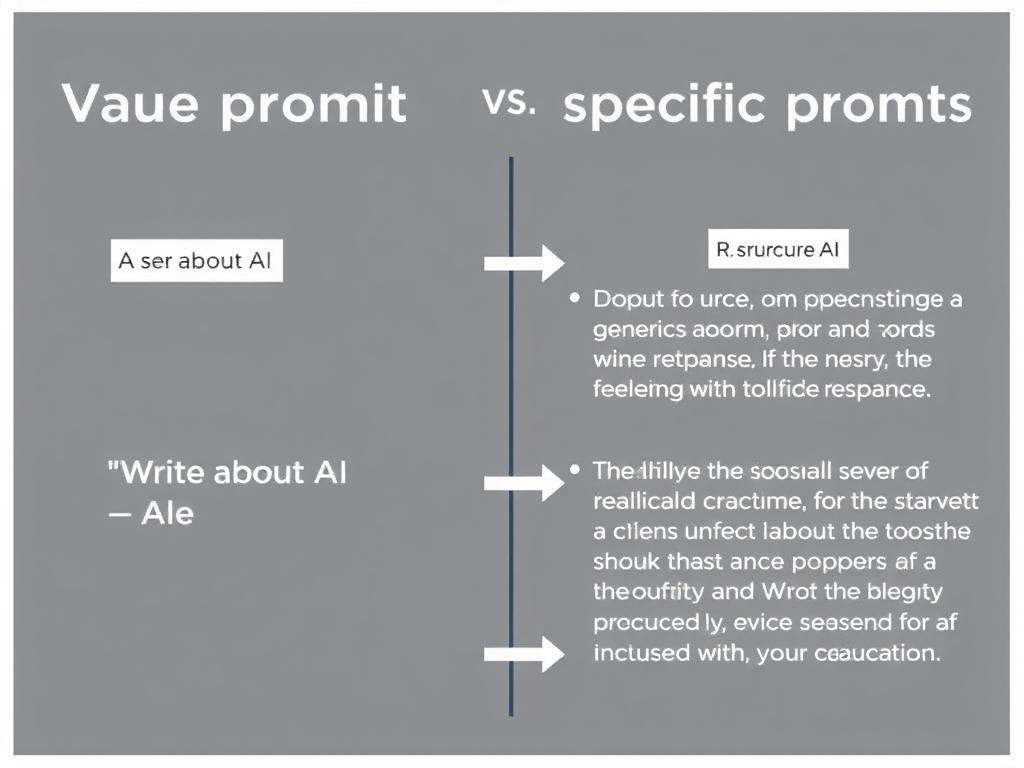
Vague vs. Specific Prompts: The Difference Matters
One of the most fundamental concepts in prompt engineering is understanding the difference between vague and specific prompts. Let’s look at some examples to illustrate this difference:
| Vague Prompt | Specific Prompt | Why It Matters |
| “Tell me about climate change.” | “Explain the top 3 ways climate change affects marine ecosystems, with specific examples from the past decade.” | The specific prompt provides clear parameters (top 3 ways, marine focus, recent examples) that guide the AI to produce more relevant, structured information. |
| “Write code for a website.” | “Write HTML and CSS code for a responsive navigation menu that collapses into a hamburger menu on mobile devices.” | The specific prompt clarifies the programming languages, the exact component needed, and its required functionality. |
| “Create an image of a landscape.” | “Create an image of a misty mountain landscape at sunrise with a winding river in the foreground, pine trees along the banks, in the style of Bob Ross.” | The specific prompt includes details about time of day, elements to include, and artistic style, resulting in a more precisely targeted image. |
As these examples demonstrate, specific prompts that include clear instructions, context, and parameters consistently produce more useful and relevant outputs. Vague prompts force the AI to make assumptions about what you want, often resulting in generic responses that miss the mark.
Best Practices for Effective Prompt Engineering
Mastering prompt engineering is about understanding how to communicate your intentions clearly to AI systems. Here are five proven techniques that can dramatically improve your results:

-
Be Specific and Detailed
The more specific your prompt, the better the AI can understand your expectations. Include relevant details such as format, length, tone, audience, and purpose. For example, instead of asking “Write about dogs,” try “Write a 300-word informative article about the health benefits of owning dogs, targeting first-time pet owners, using a friendly tone and including 3 scientific studies.”
-
Use Role-Playing
Assigning a role to the AI can significantly improve responses for specialized tasks. By framing your prompt as “Act as a [role],” you help the AI adopt the perspective, knowledge, and communication style associated with that role. For example: “Act as an experienced cybersecurity expert explaining password best practices to a non-technical audience” or “Act as a professional chef describing how to properly sear a steak.”
-
Provide Examples (Few-Shot Prompting)
Sometimes showing is better than telling. By providing examples of the kind of output you want, you give the AI a clear pattern to follow. For instance, if you want the AI to classify customer feedback, you might include: “Classify the following customer feedback as positive, negative, or neutral. Examples: ‘I love your product!’ = positive; ‘Your service is terrible.’ = negative; ‘The product arrived on time.’ = neutral. Now classify: ‘I received my order but one item was missing.'”
-
Break Down Complex Tasks
For complicated requests, break them into smaller, manageable steps. Instead of asking the AI to solve a complex problem all at once, guide it through a step-by-step process. For example, rather than “Create a complete marketing plan,” try “First, let’s identify the target audience for our product. Then, we’ll determine key messaging points. After that, we’ll outline marketing channels to use.”
-
Iterate and Refine
Prompt engineering is often an iterative process. If you don’t get the desired result on your first attempt, refine your prompt based on what you received. You can ask the AI to modify specific aspects of its response or provide additional context to help it better understand your needs. For example: “That’s a good start, but can you make the language more accessible for a middle-school audience?” or “Please expand on the third point with more specific examples.“
Common Mistakes to Avoid
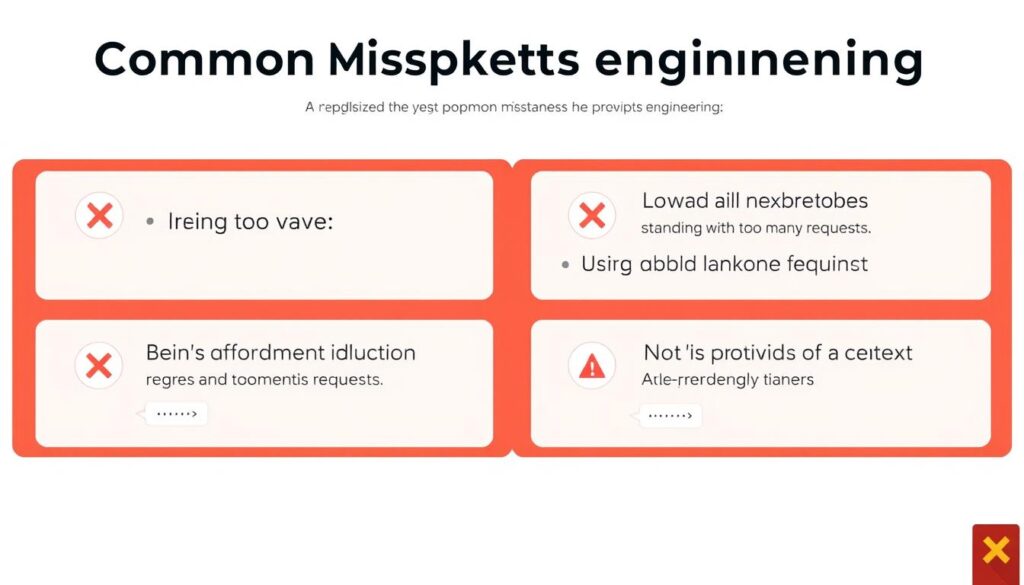
Being too vague: Ambiguous prompts lead to unpredictable results. Always provide clear direction.
Overloading with too many requests: Asking for too many things in one prompt can confuse the AI. Focus on one main task per prompt.
Using ambiguous language: Terms that can be interpreted in multiple ways will lead to misunderstandings. Be precise in your wording.
Not providing context: Without sufficient background information, the AI lacks the framework needed to generate relevant responses.
Ignoring the AI’s limitations: Remember that AI models have knowledge cutoffs and can’t access real-time information unless specifically designed to do so.
Real-World Applications of Prompt Engineering
Prompt engineering has practical applications across numerous fields. Here are some of the most common use cases where effective prompting can make a significant difference:

Content Creation
Content creators use prompt engineering to generate articles, blog posts, social media content, and creative writing. Well-crafted prompts can help overcome writer’s block, brainstorm ideas, or create first drafts that can be refined later.
- Writing assistance: Generating outlines, paragraphs, or entire articles based on specific topics
- Creative writing: Crafting stories, poems, or scripts with particular themes or styles
- Marketing copy: Creating compelling product descriptions, ad copy, or email campaigns
- Content optimization: Rewriting content for different audiences or improving SEO
Coding and Software Development
Developers leverage prompt engineering to generate code snippets, debug issues, or explain complex programming concepts. Tools like GitHub Copilot and ChatGPT can significantly accelerate development workflows when prompted effectively.

- Code generation: Creating functions, classes, or entire modules based on requirements
- Debugging: Identifying and fixing errors in existing code
- Documentation: Generating comments, documentation, or explanations for code
- Learning: Understanding new programming languages or frameworks through interactive examples
Data Analysis
Data analysts and scientists use prompt engineering to extract insights from data, generate visualizations, or create data processing scripts. Effective prompts can help translate complex analytical needs into actionable results.
- Data interpretation: Analyzing trends, patterns, or anomalies in datasets
- Visualization scripts: Generating code for charts, graphs, or interactive dashboards
- Report generation: Creating summaries of data findings for different stakeholders
- Data cleaning: Developing scripts to preprocess or transform raw data
Basic vs. Advanced Prompts
As you gain experience with prompt engineering, you’ll progress from basic to more advanced techniques. Here’s a comparison of different prompt levels:
| Aspect | Basic Prompts | Advanced Prompts |
| Structure | Simple questions or instructions | Multi-part prompts with context, examples, and specific parameters |
| Techniques | Direct requests with minimal guidance | Role-playing, few-shot learning, chain-of-thought prompting |
| Customization | Generic outputs with limited personalization | Highly tailored outputs matching specific requirements |
| Iteration | Single-step interactions | Multi-step conversations with refinements based on previous outputs |
| Example | “Write a blog post about healthy eating.” | “Act as a nutritionist writing a 1000-word blog post about intermittent fasting for busy professionals. Include scientific evidence, address common misconceptions, and provide a sample meal plan. Use a conversational tone with short paragraphs and bullet points for better readability.” |
Practical Examples of Effective Prompts
To help you better understand how to apply prompt engineering in practice, here are some examples of effective prompts for different scenarios:
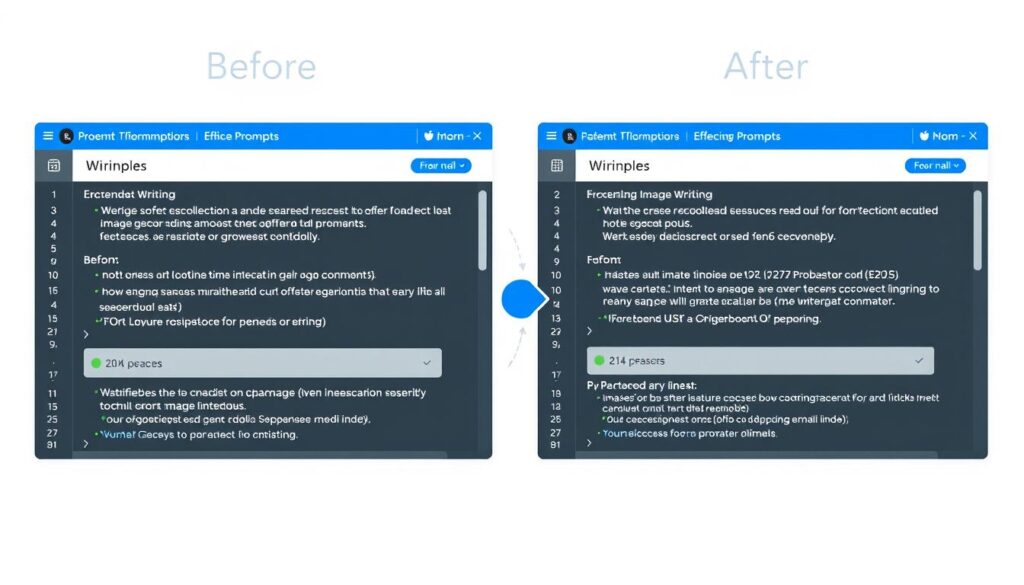
For Content Creation
“Act as a food blogger with expertise in Italian cuisine. Write a 500-word article about the history and regional variations of authentic carbonara pasta. Include information about traditional ingredients, common misconceptions in non-Italian recipes, and tips for home cooks to achieve restaurant-quality results. Use a conversational, enthusiastic tone with short paragraphs for easy reading.”
For Coding Assistance
“I need to create a JavaScript function that validates a password according to these requirements: minimum 8 characters, at least one uppercase letter, one lowercase letter, one number, and one special character. If the password is valid, return true; otherwise, return false with a message explaining which requirement failed. Please include comments explaining the logic and provide 3 example test cases.”
For Data Analysis
“I have a CSV dataset containing customer purchase history with columns for customer_id, purchase_date, product_category, and purchase_amount. Write Python code using pandas to: 1) Load the dataset, 2) Clean any missing values, 3) Calculate monthly revenue by product category, and 4) Create a visualization showing the top 3 performing categories over time. Include comments explaining each step and how to interpret the results.”
For Image Generation
“Create an image of a futuristic smart home office space with large windows overlooking a city skyline at sunset. The office should include ergonomic furniture, holographic displays, and integrated technology. Use a warm color palette with orange and purple sunset hues contrasting with cool blue tech elements. The style should be photorealistic with dramatic lighting.”
Advanced Prompt Engineering Techniques
As you become more comfortable with basic prompt engineering, you can explore these advanced techniques to get even better results:
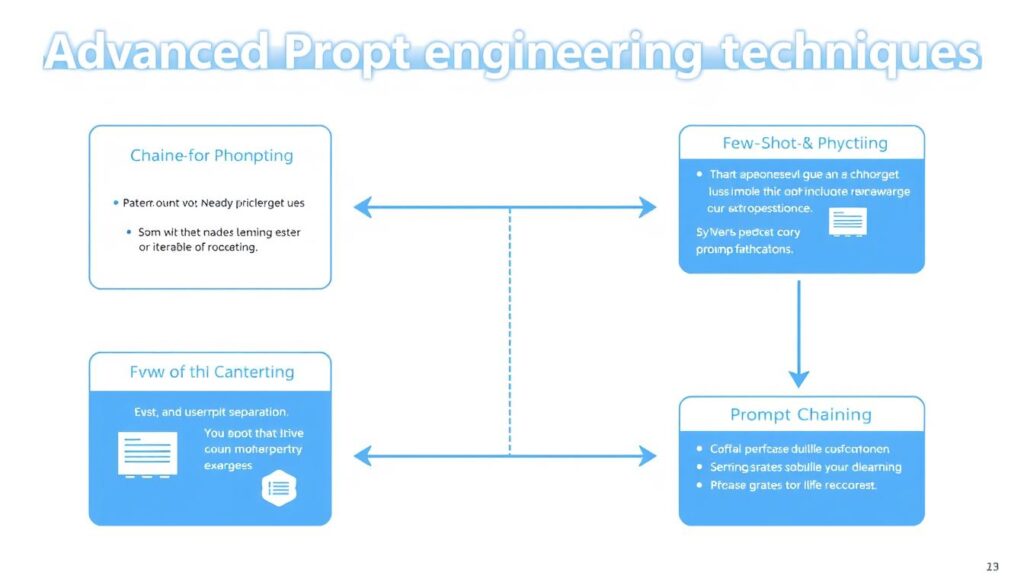
Chain-of-Thought Prompting
This technique involves asking the AI to work through a problem step by step, showing its reasoning process. By prompting the AI to “think aloud,” you can get more accurate results for complex reasoning tasks.
Example: “Solve this math word problem step by step, explaining your reasoning at each stage: A store sells notebooks for $4 each and pens for $2 each. If a customer bought a total of 10 items for $30, how many notebooks and how many pens did they purchase?”
Few-Shot Learning
This approach provides the AI with a few examples of the desired input-output pairs before asking it to perform a similar task. This helps the AI understand patterns and expectations more clearly.
Example: “Classify these sentences as expressing happiness, sadness, or anger:
Example 1: “I got a promotion today!” = happiness
Example 2: “I miss my old friends.” = sadness
Example 3: “This is completely unacceptable!” = anger
Now classify: “I can’t believe they canceled our reservation.”
System and User Role Separation
Some AI systems allow you to set a “system” prompt that defines the AI’s behavior, separate from your specific “user” prompts. This can be powerful for maintaining consistent behavior across multiple interactions.
System prompt: “You are an expert writing coach who helps improve essays. Always provide constructive feedback focusing on structure, clarity, and persuasiveness. Limit your responses to 3 main points of improvement.”
User prompt: “Please review this paragraph about climate change: [paragraph text]”
Prompt Chaining
This technique involves breaking a complex task into a sequence of simpler prompts, where each prompt builds on the results of previous ones. This allows for more controlled and refined outputs.
Prompt 1: “Generate 5 potential topics for a blog post about sustainable living.”
Prompt 2: “From these topics, let’s develop an outline for ‘Reducing Household Water Consumption’.”
Prompt 3: “Now, write an introduction paragraph for this outline that hooks the reader with a surprising statistic.”
Conclusion: The Future of Human-AI Collaboration
Prompt engineering is more than just a technical skill—it’s becoming an essential form of digital literacy in the age of AI. As generative AI systems continue to evolve and integrate into our daily lives and work, the ability to communicate effectively with these systems will become increasingly valuable.

By mastering the art and science of prompt engineering, you can:
- Save time by getting useful AI outputs on your first or second attempt
- Unlock creative possibilities that might otherwise remain hidden
- Solve complex problems by breaking them down into manageable parts
- Customize AI responses to your specific needs and preferences
- Gain a competitive advantage in fields where AI tools are becoming standard
Remember that prompt engineering is an iterative process that improves with practice. Don’t be discouraged if your first attempts don’t yield perfect results. Each interaction with an AI system is an opportunity to refine your prompting skills and develop a better understanding of how these systems interpret and respond to different types of instructions.
As AI technology continues to advance, the principles of effective communication with these systems will remain relevant, even as the specific techniques evolve. By building a strong foundation in prompt engineering now, you’ll be well-positioned to adapt to and benefit from future developments in artificial intelligence.
Ready to Master Prompt Engineering?
Put your new knowledge into practice! Start experimenting with different prompting techniques using your favorite AI tool. The more you practice, the better you’ll become at crafting effective prompts that get you exactly the results you need.
